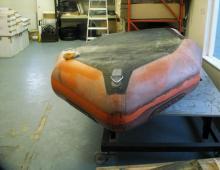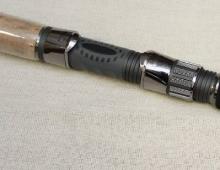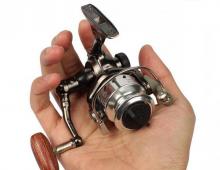Feeder rod - how to choose? Feeder rod device
If an angler feels like switching to other fishing methods, a feeder rod will be a good solution to this issue. However, in order to choose a convenient, high-quality tackle, there are several ways. You can choose a rod based on the advice of friends, sellers of specialized stores or printed sources. There is no one-size-fits-all gear that is perfect for everyone. Therefore, you should pay attention to the advice of experts, as well as reviews of the feeder rods that exist today.
Where is the feeder used
When choosing a fishing rod, you should determine in what conditions the tackle will be used. To understand how to choose a fishing rod, you should pay attention to the area where you plan to fish. If this is a small river, the distance from coast to coast of which does not exceed 100 m, then it is worth considering whether it is necessary to use a long feeder rod under these conditions. It can become a hindrance in such conditions. Here, rather, a picker will do.
In addition, if a large number of shrubs and trees grow on the shore, hanging over the water itself, then shorter tackle should also be used. Otherwise, feeder fishing in such conditions will not bring any pleasure. Hooks and leashes will get tangled in the branches, which will lead to their breakage.
Therefore, when choosing a fishing rod, you should use long tackle in open areas. It is better if the river is medium or wide.
Rod test
The feeder rod has as a test the recommended weight of the lures that will be used in the fishing process. This indicator is indicated on the body of the product and has two digits. They talk about the minimum and maximum test score. The basis for specifying this range is the weight of the feeder.
The test value can be given in grams or libra. 1 lbs equals 327.45 g.
The larger the mass of the feeder and the longer the rod, the further you can cast the tackle without much effort. Therefore, the length of the fishing rod for feeder fishing should correspond to the length of the reservoir.
The weight of the feeder should be the greater, the stronger the current. Spinning rods should be selected with such a test that the feeder can remain in place of its casting and not move during the process of fishing.
Feeder rod classes
There are only 5 classes of feeder rods, which are associated with their device, length and test. 
The first class is called ultra-light and has a tackle blank of 3 m, and a test range of 10-40 g. This type is also called a picker. It is designed for water bodies without current. Picker is suitable for running fishing without making long casts.
The light class belongs to rods with a length of 3 to 3.6 m and a test of 60 g. They are used for reservoirs with a small current.
Spinning rods of the medium class are considered universal. They provide good sensitivity in both still and moving water. Their length is up to 3.6 m, and the test is 60-100 g.
The heavy feeder is designed for a feeder weighing 100-200 g. Its length reaches 4 m. This tackle will allow you to pull a fairly large fish out of the water.
The extra heavy feeder is able to support a feeder from 120 g and above. The length of the rod reaches 5 m. They will allow you to fish in the presence of even a very strong current.
Rod action
The system indicator makes it clear what flexibility the tackle blank has, how it bends under load. To understand how to choose a fishing rod, you should pay attention to this indicator. 
A fast action indicates a biting tackle when casting. When swung, the feeder will fly faster, sharply.
Slow action belongs to more flexible rods. When casting, the blank straightens with acceleration.
Experienced fishermen claim that a hard (fast) system allows you to make more accurate casts. The tip of the blank does not bend and does not lubricate the direction of the throw.
Average system (average) is an intermediate state between its fast and slow types. It will allow you to correct many errors when casting. Therefore, it is ideal for beginners. After such a system, it will be easier to determine which type of stiffness will be more convenient for the fisherman.
Slow action (slow) bends the blank on all its rings. It allows you to extinguish jerks of large fish in the process of fishing.
Rod material
A fishing rod for feeder fishing can be made of different materials. 
The most expensive blank is made of high modulus graphite. This material is used by manufacturers such as Salmo Diamond, Taifun, Daiwa, Aqua Tornado and others. This is a strong and at the same time light type of rod. It has the disadvantage of being sensitive to damage, so it should be handled with care.
Composite rods are somewhat cheaper. They are unpretentious, but they have more weight than the previous version. These rods include Trabucco, Shimano, Ultraviolet and others.
Fiberglass blanks are characterized as rather heavy and rigid products that are not afraid of mechanical stress. This is the cheapest option. The most famous manufacturers of such gear are Kosadaka, Mikado and others.
Blank design
There is a plug-in and a telescopic one. User reviews are divided on which type is better. Some anglers prefer the compactness of the telescopic blank. Others are a multi-part variant with plug-in connections.
As a rule, a plug rod has a larger number of guides. This allows you to evenly distribute the load throughout the rod.
According to the reviews of fishermen, a feeder rod with a telescopic blank is somewhat inferior in this indicator to the plug variety. Pass rings are located one at the end of each section. Feeder fishing with such gear is less convenient, especially when pulling rather large fish out of the water. Therefore, when choosing a suitable rod, you should pay attention to the number of rings on the blank.
Access rings
The rings of each fishing rod are designed for the use of a certain type of gear. It can be a braided cord or fishing line. Using the wrong type of material can damage the rings. Casts will be inaccurate, the process of catching will become difficult and uncomfortable. 
To use the cord, the rings must have special inserts. As a rule, cheap rods do not have them. Even from the same manufacturer, each series can be designed for different types of gear. So, for example, the Shimano Nexave AX series rod is equipped with a friction ring protection, while the Beast Master series does not have special ring protection.
In the production of inserts for through-rings, cermets are most often used coated with silicon carbide, titanium nitride, aluminum oxide or porcelain.
Feeder tops
Quite often, the reason for the breakage of the rod is a fracture of the tip. This can happen with an accidental impact on rocks, trees, when overwhelmed by a tulip.
When buying a feeder, you should pay attention to the diameter of the base of the top. It is in the range from 2.2 to 3.5 mm.
The material from which the top is made also matters. The device of the feeder rod involves the production of this element from fiberglass, carbon fiber or carbon fiber. Each of them has its own test form.
It is better to choose those vertices that have digital markings. Their error is much lower. The test range can be specified in grams or oz equals 28.35 g). It is better if the manufacturer provides additional peaks with the fishing rod.
Reviews of fishermen about cheap feeders
Fiberglass products are considered cheap feeder rods. These are mostly Chinese products. The most famous brands of such products are Mikado, Kosadaka and others. 
The Chinese manufacturer Kosadaka is known for the Millennium Feeder series of tackle. This is a strong, heavy and rather unpretentious feeder rod. Reviews of fishermen highlight it as the best tackle in terms of price / quality ratio. They are designed for fishing in fast currents. According to the five-point system, the fishermen gave the presented products an estimate of 4.45.
The Mikado brand produces products in several series. The Sensei Light Feeder is a fairly stiff yet lightweight option for fishing in small to medium currents. It is rated by fishermen at 4.33. For a strong current, this manufacturer has released the SCR Heavi Feeder series. She is rated 5 points by users. These are quite good options for the low-price segment.



